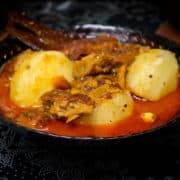Malaysian-Javanese style vegan massaman curry
Like with any dish from any place, there are regional variations that impart different touches. Case in point is this vegan massaman curry recipe, which is akin to the style most people are familiar with but with more Javanese-Malaysian influence. This massaman contains no curry paste, unlike the more well known central version. The number of ingredients and accompanying notes, plus what might seem like lengthy instructions, make this recipe seem more complicated than it is. The recipe is based on a translation from the Thai cookbook อาหารมุสลิม published by Sangdad.
Ingredients
- 250 millilitres coconut cream, divided see notes1
- 250 millilitres vegetable or other flavourless oil, divided
- 7 Thai cardamom pods or 5 green, pressed lightly with the back of a knife to crack open. See notes2
- 5 cloves
- 1 3-inch piece cinnamon
- ⅓ cup sliced shallot
- 1 ½ tablespoons minced garlic
- 1 ½ tablespoons toasted coconut see notes3
- 1 tablespoon minced ginger
- 2 ¼ teaspoons deggi mirch or other Indian chilli powder see notes4
- 1 ½ teaspoons ground coriander
- ½ teaspoon ground cumin
- ½ teaspoon ground white pepper black pepper or a mix is okay too
- ½ teaspoon ground turmeric
- 150 millilitres coconut milk see notes5
- 2 teaspoons salt
- 3 tablespoons palm sugar
- 200 grams potato peeled and boiled in salted water until fork tender, and cut into 1 inch chunks
- 1 ½ - 2 cups cooked seitan or fake chicken, tofu, etc...
- 2 tablespoons roasted peanuts
- 2-3 tablespoons tamarind water see notes6
Instructions
- Add all but about 125 millilitres (¼ cup) of the coconut cream as well as half of the oil to a medium saucepan (not a saute pan as you want to give some room for oil to splatter inside) and turn the heat to medium. When the liquid begins to bubble, add the cardamom, cloves, cinnamon, and shallot. Cook, stirring frequently to avoid scorching, for 8-10 minutes, until the shallot begins to brown slightly and the mixture smells fragrant with the spices. The coconut cream will probably have broken down a bit by now and the contents of the pan will be more translucent.
- Meanwhile, pound the garlic, toasted coconut, and ginger into a paste using a pestle and mortar. Add to the oil along with the chilli powder, ground coriander, ground cumin, ground pepper, and turmeric. Stir to combine the spices with the oil. Cook, again stirring almost constantly to avoid scorching, for about 5 minutes, until the rawness of the garlic is cooked out.
- When the contents of the pan start to bubble again, add the thinner coconut milk, salt, sugar, and the remaining oil. Turn the heat down to medium low and simmer for 10 minutes.
- Give it a good stir to make sure the sugar is broken up and dispersed and then add the remaining coconut cream, potatoes and seitan. Cook for another 5 minutes. Add peanuts and tamarind juice.
- Now the most important part. Taste the curry and adjust the seasonings if you think they need to be adjusted. The flavour is intended to be quite salty, with a balance of mild sweetess and bright sourness to follow. Add more salt, sugar, and tamarind liquid to balance. Eat with steamed rice or roti.
Notes
1. You don't need to specifically buy coconut cream. Just scoop the fat from the top of a can of coconut milk with a high fat content (and preferably no emulsifiers).
2. Thai cardamom pods are white and round, and can sometimes be found in Thai supermarkets abroad. Some argue it is less pungent than green cardamom, hence reducing the quantity of pods if you can only find green cardamom.
3. To make toasted coconut, all you need to do is add freshly grated or dessicated coconut to a pan and cook, stirring often, over low heat until the contents are toasty brown but not burnt. If you use freshly grated coconut, add a little more than you think to the pan as it will shrink with cooking.
4. If you don't like a lot of spicy heat you can use ½ teaspoon chilli powder + ¾ teaspoon paprika (using paprika as a partial substitute for dried chilli is a trick I learned in the cookbook Kiin by Nuit Regular).
5. When coconut milk is used to add liquid to a Thai coconut curry after the paste has been fried in the cream, the milk is often much thinner than what you'd find in a can of coconut milk abroad. Hence I used a about 50% each water and coconut milk.
6. Tamarind liquid is easy to make and the results are better than the contents of most jars or bottles of tamarind paste/tamarind concentrate you can buy.
